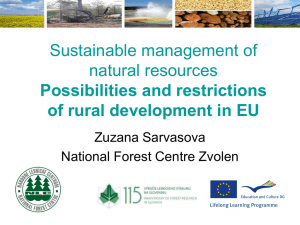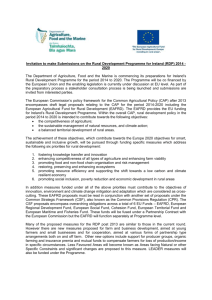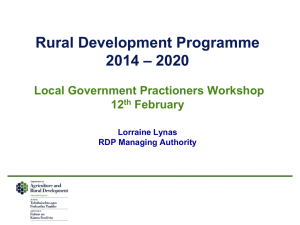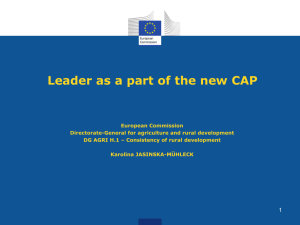Strategic approach and programme design
advertisement
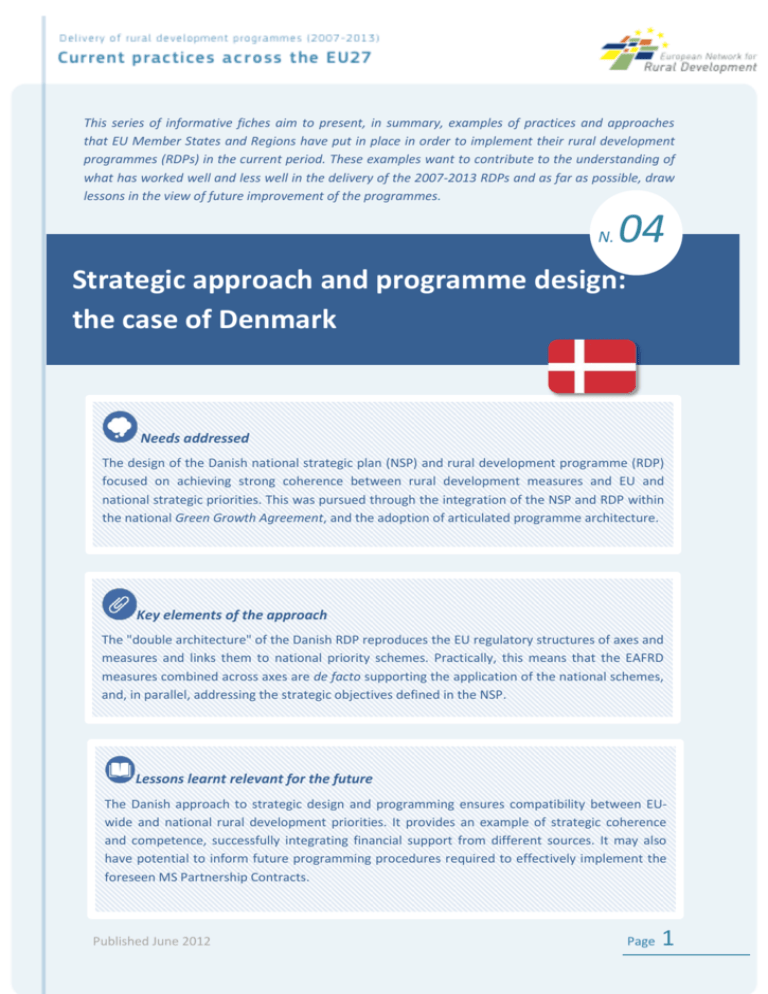
This series of informative fiches aim to present, in summary, examples of practices and approaches that EU Member States and Regions have put in place in order to implement their rural development programmes (RDPs) in the current period. These examples want to contribute to the understanding of what has worked well and less well in the delivery of the 2007-2013 RDPs and as far as possible, draw lessons in the view of future improvement of the programmes. N. 04 Strategic approach and programme design: the case of Denmark Needs addressed The design of the Danish national strategic plan (NSP) and rural development programme (RDP) focused on achieving strong coherence between rural development measures and EU and national strategic priorities. This was pursued through the integration of the NSP and RDP within the national Green Growth Agreement, and the adoption of articulated programme architecture. Key elements of the approach The "double architecture" of the Danish RDP reproduces the EU regulatory structures of axes and measures and links them to national priority schemes. Practically, this means that the EAFRD measures combined across axes are de facto supporting the application of the national schemes, and, in parallel, addressing the strategic objectives defined in the NSP. Lessons learnt relevant for the future The Danish approach to strategic design and programming ensures compatibility between EUwide and national rural development priorities. It provides an example of strategic coherence and competence, successfully integrating financial support from different sources. It may also have potential to inform future programming procedures required to effectively implement the foreseen MS Partnership Contracts. Published June 2012 Page 1 Context The preparation of the rural development national strategic plan (NSP) and rural development programme (RDP) in Denmark was characterised by a strong focus on achieving coherence between rural development measures co-financed by EAFRD and national support schemes under the Ministry of Food, Agriculture and Fisheries (MFAF), which address specific thematic objectives. This approach led to an RDP that embeds a "double architecture", which has its foundations on the EAFRD structure of axes and measures and integrate them with the national application schemes. This was decided with a view to promote cohesiveness and synergies between interventions and minimize potential deadweight losses. In this manner, a strong coherence between the Community strategy and national priorities was pursued. This coherence reinforced the common objectives specified at both the EU and national level, and was further enhanced by the introduction of a Green Growth Agreement (GGA). The GGA is a national policy document which assembles the strategic approaches of different national policies (on agriculture, nature and the environment) and introduces an innovative environmental strategic focus as means to achieve sustainable development in Denmark. introduction of the strategic approach to rural development programming by Regulation (EC) n. 1698/2005, a rural strategy (and programme) was developed pursuing close coordination between rural development measures financed by EAFRD and national application schemes. Subsequently, the 2009 revision process resulting from the CAP Health Check (HC) and the European Economic Recovery Package (EERP) - and the introduction of the GGA, strengthened these links and provided a strong framework for integrated initiatives. These consider: on one hand, a wide range of national concerns and, on the other; the new challenges introduced at the EU level. The definition of the rural development strategy and programme in Denmark was characterised by an effort to achieve coherence between rural development priorities at the EU and national level. This was facilitated through the adoption of a strong thematic focus which integrates national priorities with EU axes and measures. In the initial phase of the 2007-2013 programming period, the Danish authorities built upon the programming experiences from the past which envisaged four distinct types of rural development instruments1. With the 1 Namely: i) the Rural community development scheme (national funds); ii) the Rural Development Published June 2012 Programme (co-financed by the EU); iii) the Leader+ initiative; iv) other national environmental schemes. Page 2 Strategy and programme design The Danish NSP and RDP were developed in parallel. Strategic design was initiated by MFAF in May 2005 and involved the utilisation of an inter-ministerial task force. Consultation was based on regional conferences and public hearings in various parts of the country, in the context of which a wide range of agricultural, economic, social and environmental stakeholders provided inputs to the definition of the strategy. This process led to the production of the NSP and a first draft of the RDP, which was subsequently brought into consultation. The final draft of the RDP was produced in spring 2007. At the initial stage of programme definition, the Danish authorities maintained a strong programming approach based on national schemes with EAFRD measures integrated by objectives. The schemes were structured on a thematic basis and included, amongst other topics: food product quality; extensive production on agricultural land; establishment and management of wetlands; investments in biogas plants; sustainable forestry; new jobs in rural areas, and; skills acquisition. Subsequently further effort was put in place to ensure that the EAFRD policy structure was clearly reflected in the programming approach and, as far as possible, a clear correspondence between axes and measures and the national application schemes. This process resulted into a clearer and more articulated definition of the programme without involving any substantial modification of the original objectives or the national schemes. The resulting RDP embeds what can be called a "double architecture": on one hand it reproduces the EU regulatory structure of axes Published June 2012 and measures and, on the other hand it links them to the national application schemes. In practical terms this means that the strategic objectives of the RDP are achieved with the measures of the four axes, very often combined across them according to the thematic focus indicated by the national application schemes. In this process the reference framework provided by the NSP ensures coherence between the EU and the national priorities. The changes introduced in 2009, following the revision of the strategy, further strengthened this coherence introducing a strong environmental focus. Through the introduction of the GGA the emphasis is put on promoting the sustainable competitiveness of the farm and food industries and accommodating societal demands related to wider environmental issues, thus reflecting the challenges introduced by the CAP Health Check. From the point of view of programme implementation, the double architecture of the Danish RDP allows a single measure to Page 3 contribute to the achievement of several thematic objectives (i.e. national schemes). At the same time, this also means that a single application scheme is implemented through a range of measures. Indicatively, the national scheme promoting “new jobs in rural areas” can be served by measures from axes 1, 3 and 4; while a specific RDP measure (e.g. measure 121) can serve more than one national priority scheme (e.g. innovation and development in primary agriculture and forestry; investments in biogas plants; food product quality development). In this context, from an administrative and delivery perspective, the national application schemes remain the main reference support tools both for the implementing authorities and beneficiaries, while the correspondence between EAFRD measures and national schemes often appears at the level of submeasures. The strategic orientation of the Danish RDP is strongly shaped by the sustainable development model introduced by the Danish government's "Green Growth Agreement" at the same time fitting into the wider development priorities as defined in the EU Community strategic guidelines - as modified by the HC. Coherence between EAFRD and national priorities is achieved through integrating EU measures and axes with national application schemes. Published June 2012 Conclusions and relevant lessons The Danish approach to strategy definition and programme design has led to the specification of a highly coordinated rural development policy, with a strong focus on clearly defined strategic objectives, coherent with both EU and national priorities. In practical terms, this has been translated in the flexible use of EAFRD measures following a thematic approach. The Danish approach to achieving this has in a way anticipated a key strategic element now envisaged by the EC’s legislative proposals for rural development policy after 2013. Namely, placing emphasis on a more flexible relationship between measures and their combination by objectives/priorities. The "double architecture" of the Danish RDP is based on the clear definition of policy objectives, and facilitates coherence between EU priorities and national/regional needs, as well as better targeting of EAFRD support. The Danish example also demonstrates a policy based on a coherent set of strategic objectives and operating through a single unified framework, which successfully integrates financial support from different sources. Thus it may also have the potential to inform some of the programming procedures that will be required to effectively implement the MS Partnership Contracts, foreseen for the 20142020 programming period. These will require a strategic coherence stemming from wider EU priorities (as specified in the Europe 2020 strategy) and a match with specific rural development objectives and other objectives which reflect national/regional contexts. Page 4 Some constraints linked to this approach have been identified. First, though the "doublearchitecture" structure of the Danish RDP identifies correspondence between national schemes and EU measures, it has raised some questions on how the consistency between national and EU-wide objectives is ensured and what this implies in terms of strategic targeting, quantification of objectives, monitoring and evaluation. Also, this architecture affects the availability of information required for complying with the EU Common Monitoring and Evaluation Framework and further and continuing effort is needed to “translate” data extracted from the national delivery system to the EU one. The integration between RDP measures and national priorities is a key factor which facilitates strategic coherence at the MS level and can lead to the further improvement of the efficacy of public interventions in EU rural areas. Information included in this fiche is primarily coming from the case studies carried out within the ENRD Thematic Working Group 4 “Delivery of EU rural development policy”. The fiche is compiled by the Contact Point on the basis of the information collected in the EU Member States and Regions and takes into account views expressed at the European, national and regional level. This notwithstanding, the content does not necessarily reflect the official position of the EU institutions and national authorities. Published June 2012 Page 5
